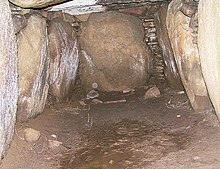Passage grave from Hulbjerg
The passage grave of Hulbjerg is located in the south of the Danish island of Langeland on the 15 m high hill Hulbjerg south of the ferry port Bagenkop 200 m east of the farm Søgård . The passage grave ( Danish Jættestue ) was built around 3300 to 3200 BC. Built during the Neolithic Age and belongs to the Nordic megalithic systems of the Funnel Beaker Culture (TBK). The passage grave is a form of Neolithic megalithic systems , which consists of a chamber and a structurally separated, lateral passage. This form is primarily found in Denmark, Germany and Scandinavia, as well as occasionally in France and the Netherlands. Neolithic monuments are an expression of the culture and ideology of Neolithic societies. Their origin and function are considered to be the hallmarks of social development.
description
The rectangular chamber is located in a round mound with a diameter of around 20 meters, which is completely enclosed with curb stones. It measures 6.5 × 2.0 meters and is bordered by 13 supporting stones. Three of the original five cap stones of the chamber ceiling are still original. The remaining two were supplemented in 1961 with granite beams . The chamber floor consists of stone slabs. At the southern end of the chamber, upright panels separate a quarter .
At two points of the corridor, which is five meters long and low, but unusually wide for systems of this type, there are doorframe and threshold stones . At the end of the corridor is a large, flat stone that probably served as the outer locking stone.
Finds
In the quarter and in the inner part of the corridor, ceramics, flint and amber as well as large piles of bones from 36 adults and 17 children were found in the excavation in the early 1960s . In the corridor there was a skull with traces of trepanation . If this is not done post mortem, a molar tooth with a hole indicates the oldest known possibility of dental treatment.
The large stone grave is located on a public area and is accessible all year round. The finds are exhibited in the Langelands Museum in Rudkøbing .
The Runddysse von Lunden lies further to the east . To the south are the Gulstav dolmens
See also
literature
- Karsten Kjer Michaelsen : Politikens bog om Danmarks oldtid (= Politikens håndbøger. ). Politiken, Copenhagen 2002, ISBN 87-567-6458-8 , pp. 146, 147 and 162.
- Ingrid Falktoft Anderson: Vejviser til Danmarks oldtid . 1994, ISBN 87-89531-10-8 , p. 231
Individual evidence
- ^ Johannes Müller : Neolithic Monuments and Neolithic Societies. In: Hans-Jürgen Beier , Erich Claßen, Thomas Doppler, Britta Ramminger (eds.): Varia neolithica VI. Neolithic Monuments and Neolithic Societies. Contributions from the meeting of the Neolithic Working Group during the annual meeting of the North-West German Association for Ancient Research in Schleswig, 9. – 10. October 2007 (= contributions to the prehistory and early history of Central Europe. Vol. 56). Beier & Beran, Langenweißbach 2009, ISBN 978-3-941171-28-2 , pp. 7-16, here p. 15.
Web links
Coordinates: 54 ° 44 ′ 10 ″ N , 10 ° 41 ′ 13 ″ E



